Daedalus › Daigoji › The Roman Theatre of Orange » Origins and History
Articles and Definitions › Contents
- Daedalus › Who Was
- Daigoji › Origins
- The Roman Theatre of Orange › Origins
Ancient civilizations › Historical places, and their characters
Daedalus › Who Was
Definition and Origins
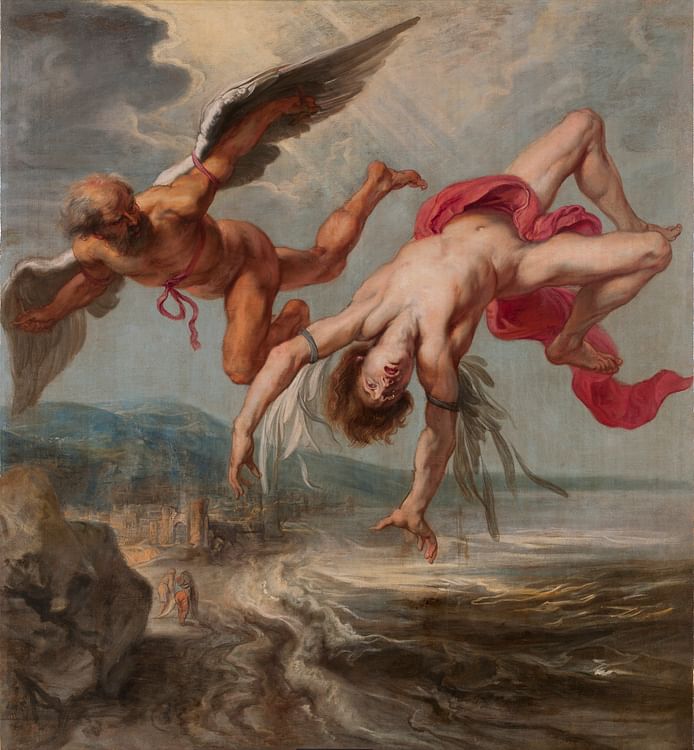
Daedalus is a figure from Greek mythology famous for his clever inventions and as the architect of the Minotaur ’s labyrinthon Crete. He is also the father of Icarus who flew too close to the sun on his artificial wings and so drowned in the Mediterranean. By the Roman period, Daedalus had acquired a long string of accomplishments and he came to represent, in general, the supreme master craftsman. The myths of Daedalus appear in the works of such noted writers as Homer, Herodotus, Ovid, and Virgil.
ORIGINS
The ancient Greeks closely associated Daedalus (also spelt Daidalos) with the god Hephaistos, the genius craftsman of Mt.Olympus. It is possible that both figures have their origin in the Phoenician and Ugarit god Kothar, who was also considered a skilled artisan. In addition, it seems likely that highly valued artworks traded by the Phoenicians and reaching Greece, especially Crete, gave rise to myths concerning the fabled craftsmen of the Near East. Moreover, the very word daidalossignified 'finely-worked' and 'elaborate'.
CRAFTSMAN TO KING MINOS
In Book 18 of the Iliad, Homer mentions that Daedalus lived at Knossos on Crete and designed an open-air dance floor there for King Minos' daughter Ariadne. He is credited in later sources as offering his considerable skills for other projects on Crete, specifically, designing the wooden bull that Minos' wife Pasiphae used to capture the affections of the bull she was in love with, building Minos' palace, and constructing the labyrinth where the offspring of that union, the half man-half bull Minotaur, dwelt.The same sources also report that Daedalus made the thread which Ariadne gave to the hero Theseus so that he might kill the Minotaur and escape from the labyrinth.
IN ANTIQUITY, DAEDALUS WAS CREDITED AS THE CREATOR OF AN EVER-INCREASING NUMBER OF FABULOUS INVENTIONS & ARTWORKS.
DAEDALUS & ICARUS FLEE CRETE
Daedalus fell out of favour with King Minos, probably, and perhaps understandably, for the cow he had built Pasiphae, and he and his son Icarus were forced to flee for their lives. For this purpose, Daedalus constructed wings so that the pair might fly with ease from the wrathful king. Daedalus warned his son that for the wings to function best he should not fly too close to the sea lest the moisture render the feathers too heavy and useless, nor should he fly too high or the sun's heat would likewise damage the wings.
The young Icarus, alas, did not heed his father's advice and, on over-reaching himself and flying too close to the sun, the heat melted the wax which attached the wings to his arms. As a consequence, he plummeted into the sea and drowned in a tale that reminded of the folly of over-ambition. The tragedy was commemorated in the naming of the stretch of waters in that area the Icarian Sea, and then, when Hercules dragged the washed up body to an island, he re-named that place Icaria in honour of the fallen youth. The island still bears the name today and lies just south-west of Samos.
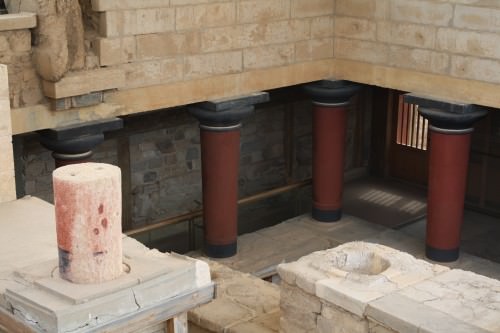
The Palace of Knossos
DAEDALUS ON SICILY
Meanwhile, Daedalus had made it safely to Sicily where he was looked after by King Cocalus (also spelt Kokalos). In gratitude to Hercules, Daedalus sculpted a fantastically life-like statue of the hero. Unfortunately, this statue came to an unfortunate end one night, when Hercules himself stumbled across it and, convinced by its realism, thought it an enemy and smashed it to pieces. At the same time, King Minos had not simply allowed his talented architect to escape scot-free and actually pursued him all the way to Sicily but upon landing the daughters of Cocalus boiled him alive in a steam bath. Daedalus soon gave Cocalus reason to be glad for his arrival as he continued to produce such masterworks as a golden ram (or honeycomb) for the temple of Aphrodite on Mt. Eryx, a fortress at Acragas ( Agrigento ), and a steam bath at Selinus ( Selinunte ).
THE LEGEND OF DAEDALUS GROWS
From the 5th century BCE, Athens claimed the artist as one of their own, and Theseus was considered to have brought him back to Athens, replacing Crete as his place of birth and Sicily as his final destination. A whole family tree was devised so that such figures as Socrates claimed descent from Daedalus. The craftsman was given a nephew, Talos, the man of bronze who protected Crete, whom he killed, jealous of the younger man's invention of the saw, compass, and potter's wheel. This murder explained why Daedalus was exiled to Crete. Over the following centuries, Daedalus was credited with an ever-increasing number of fabulous inventions and artworks, from living statues to the magnificently decorated golden doors of the temple of Apollo at Cumae, Italy. He was even said to have invented the walking pose of early Greek statues, differentiating them from earlier and somewhat static Egyptian figures and paving the way for the more life-like poses of later Greek sculpture. The Romans even made Daedalus the patron of carpenters.

Daedalus & Pasiphae
DAEDALUS IN ART
Daedalus and Icarus appear in Greek art, especially pottery painting. The earliest Greek example may date to c. 560 BCE.The pair also appear on an Etruscan gold amulet ( bulla ) from c. 470 BCE. Daedalus' labyrinth was used as a symbol on Cretan coins and was a popular motif for Roman mosaic makers. In Greek drama, Daedalus was the subject of several satyr plays and comedies, including those by such notable playwrights as Sophocles and Aristophanes. The Roman writer Ovid gave the figure a new lease of life in the Roman era by describing Daedalus' adventures in his Metamorphosis (Bk. 8).Consequently, he became a favourite subject of Roman painters, notably seen in a 1st-century CE wall -painting of the House of the Vettii at Pompeii. Even in the modern world Daedalus' name lives on as a style of Archaic sculpture (Daedalic) which demonstrates the orientalizing features seen in early Greek sculpture.
Daigoji › Origins
Definition and Origins
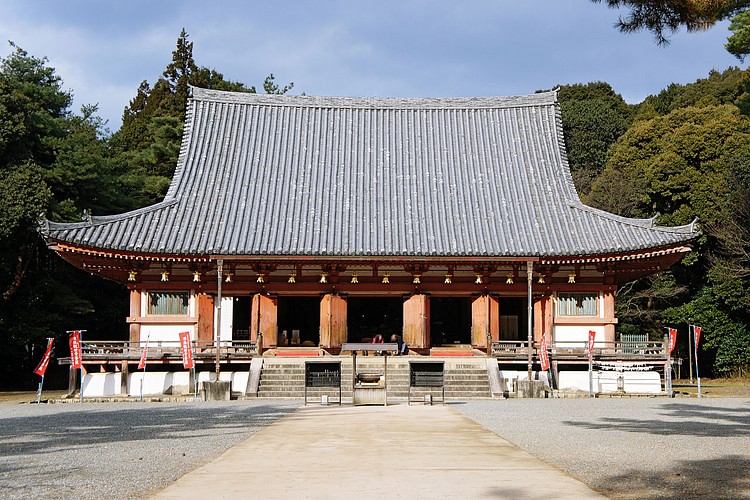
Daigoji is a Shingon Buddhist temple complex in Kyoto (ancient Heiankyo ), Japan, which was founded in 874 CE by the scholar monk Shobo (aka Rigen Daishi). The site established close ties with the imperial family and became an important place of pilgrimage. The famous pagoda of Daigoji is the oldest building in Kyoto. The temple complex has 70 wooden structures, 18 National Treasures of Japan and is a UNESCO World Heritage Site.
A ROYAL TEMPLE
Daigoji is one the head temples of the Shingon Buddhist sect and is located in southern Kyoto in an area which was once on the outskirts of the capital of Japan, Heiankyo. Here the monk Shobo, posthumously known as Rigen Daishi (Great Master of Holy Treasures), received a vision by a natural spring and so he built a simple hermitage for himself in 874 CE and the first temple later in the 9th century CE. The monastery received the backing of Emperor Daigo (r. 897-930 CE), and in 919 CE he decreed that only monks descended from Shobo's family line could hold the position of Lord Abbot. More importantly, the abbot would acquire the rank of zasu, which put him on an equal footing with the abbots of the other great monasteries of Japan: Enryakuji and Kongobuji. The complex would enjoy further imperial support over the next century which saw the site expand and benefit from an exemption from tax.
Daigoji continued to be a major imperial-sponsored temple through the years, as is evidenced by the burial at the site of emperors and their consorts including Emperor Suzaku (930-946 CE), Emperor Murakami, and the consorts of Emperor Shirakawa (1073-1086 CE) and Go-Toba (1183-1198 CE). Daigoji became a famous pilgrimage site, and a tradition developed whereby emperors would pray at the site whenever they were expecting a royal birth. Another tie to the imperial family was the holding of office of abbot by royal personages, for example, Lord Abbot Kakugen was the son of Emperor Kazan (984-986 CE).
THE STAR ATTRACTION & SYMBOL OF DAIGOJI, IS THE FIVE-ROOFED PAGODA, KYOTO'S OLDEST BUILDING.
A new round of building occurred from 1115 CE under the auspices of the Lord Abbot Shokaku when the Sambo-in area was developed and the landscape gardens built. By the end of the 12th century CE, the complex had become a major centre of learning and boasted five subtemples, the Daigoiji gomonzeki (Five Aristocratic Temples of Daigoji), 42 main halls, four pagodas, three royal villas, and 183 dormitories for monks.
KAMI DAIGO
The Daigoji complex is divided into two distinct areas: the Shimo Daigo (Lower Daigo) and Kami Daigo (Upper Daigo), the latter also being the name of the mountain on whose wooded slopes it is built. The upper precinct is the site of the original temple founded by Shobo. One of the most important structures in the Kami Daigo is the Yakushido Hall. Today's version was built in 1121 CE, and it contains ancient artworks which include an image dating to 907 CE when the original building was constructed. The spring which convinced Shobo to build on the site is now enshrined in its own wooden enclosure.

Daigoji Pagoda, Kyoto
SHIMO DAIGO
Nestling at the base of the mountain, 4.5 km (2.5 miles) from the Kami Daigo, the lower precinct was developed from 926 CE, when the site received imperial patronage, and includes the massive Main Golden Hall (Kondo) with its impressive sloping roof which dates to the Kamakura Period (1185-1333 CE). Here, too, are the Sambo-in or Monastery of the Three Treasures (first built in the 12th century CE), the Imperial Messenger Gate (not actually used as a gate), and gardens famous for their cherry blossoms, the Benten Pond with its wooden bridge and shrine, and the site's museum. Also architecturally significant are the Front Reception Hall ( Omote- shoin ) and the Inner Reception Hall ( Oku- shoin ) which are examples of 16th-century CE domestic buildings in the shoin - zukuri style. Inside both buildings, the walls and sliding paper screens ( fusuma ) are painted with landscape pictures.
The star attraction of the Shimo Daigo precinct, and symbol of Daigoji in general, is the five-roofed pagoda, Kyoto's oldest building, which was erected in 951 or 952 CE thanks to the sponsorship of Emperor Murakami (r. 946-967 CE). The wooden pagoda is 34 metres high and a fine example of Fujiwara style architecture. It contains several examples of paintings from ancient Japan, including depictions of the eight patriarchs of Shingon Buddhism, although, unfortunately, it is not open to the public.
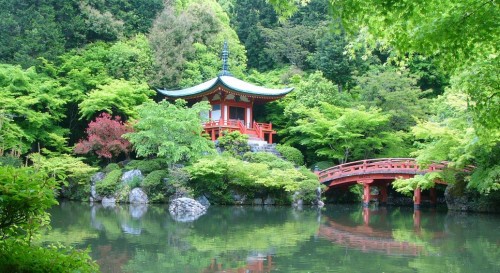
Benten Pond, Daigoji
LATER HISTORY
As with many other ancient buildings in Japan the site suffered its fair share of destruction, both deliberate and accidental, especially during the Onin War (1467-1477 CE). Toyotomi Hideyoshi, the 16th-century CE imperial regent, restored the site's main temple and beautified the Sambo-in gardens. According to the diary of Gien, the abbot at the time, Hideyoshi personally landscaped the gardens to his own liking, bringing in 700 large stones for the purpose which he selected for their unusual shape and then placed for a maximum aesthetic effect. Many stones were pinched from other scenic sites across Japan, and some even came from his own pleasure palace, the splendidly named Mansion of Collected Luxuries or Juraku-dai. Since Hideyoshi's efforts, many of the other buildings at Daigoji have been similarly restored.
Today Daigoji is still a working temple and monastery, the upper precinct continues to be a place where monks practise asceticism ( Shugendo ), and it remains a passage on major pilgrimage routes. As a UNESCO World Heritage Site since 1994 CE and home to many important ancient buildings and artworks Daigoji is, of course, also popular with tourists, especially those keen to see each spring the celebrated cherry blossoms of the Sambo-in gardens.
This article was made possible with generous support from the Great Britain Sasakawa Foundation.
The Roman Theatre of Orange › Origins
Ancient Civilizations
The Roman theatre of ancient Arausio (modern day Orange in southern France) is one of the best-preserved examples from antiquity. Built in the 1st century CE, it once had capacity for 9,000 spectators and is dominated by its massive stage wall with an ornate façade decorated with columns, doorways, and niches. The theatre was listed as a UNESCO World Heritage Site in 1981 CE.
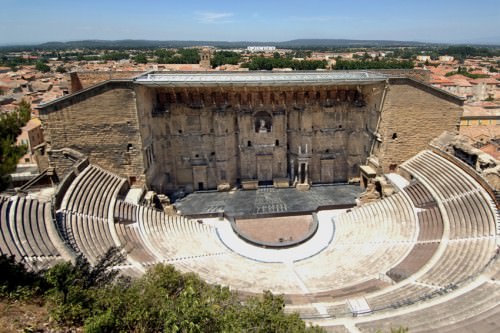
Roman Theatre, Orange
REGIONAL HISTORY
The Celtic site of Arausio, named after a spring deity, first attracted the interest of the Romans during the 2nd century BCE following a call from Massalia (modern Marseilles) for support against local tribes. A series of conflicts ensued which included battles with invading Danish tribes, the Cimbri, and Teutones. Eventually, the area of Provence was brought under Roman control and, between 44 and 27 BCE, Arausio was made available to veterans of the Legion II and given the status of a colony; its full official title being Colonia Iulia Firma Secundanorum Arausio. The city prospered due to its location on trade routes and fertile lands and was given the typical collection of Roman monumental architecture such as temples, a forum, a triumphal arch, Roman baths, and, of course, a theatre.
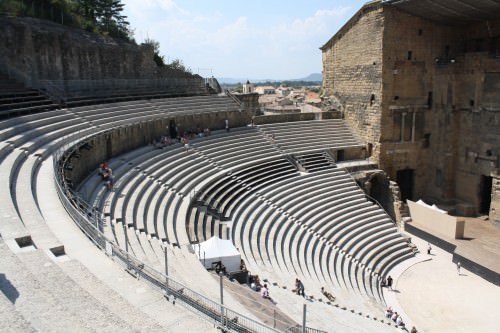
Cavea, Theatre of Orange
DESIGN & DIMENSIONS
The theatre was constructed at the end of the 1st century CE using both local yellow and white limestone with the tiers of seating, or cavea, built into the side of St. Eutrope hill. The stone seating had three tiers of 20, 9, and 5 rows of seats and gave the theatre a capacity for around 9,000 spectators. Each tier had its own gates and entrance tunnel ( ambulacrum ), and spectators could not access one tier to another once inside the theatre. The seats of the first three rows were reserved for VIPs such as the municipal councillors ( decurions ), and some still bear inscriptions. Although now restored, some of the original seating is still in situ at the top sections near either side of the stage.

Columns, Orange Theatre Stage Wall Facade
The stage wall ( scaenae frons ) measures 103 metres in length, 13 metres in depth, and is 37 metres high. The three-storied wall is set with multiple doorways (including the main central entrance doorway or valva regia ), windows, and niches arranged in bays. The façade was further enhanced with up to 100 decorative marble and granite columns, a similar number of pilasters, mosaics, plaques, friezes, and many fine statues. The central alcove dominates the scene today with its 3.5-metre high statue of a Roman emperor, discovered in the 1930s CE and restored to resemble Augustus.
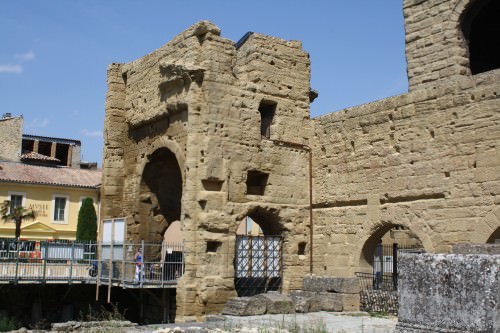
Entrance Arch, Theatre of Orange
The sides of the stage wall contain additional stage entrances ( valvae hospitales ) with their own exedra or podium and rooms once used by the actors for changing costumes and props ( postscaenium ). Thus, the elevated stage ( pulpitum ), originally of wood, is enclosed on three sides and measures over 60 metres in length. It was originally separated from the paved semi-circular orchestra by a one-metre high wall. At the top of the stage wall, stone emplacements are visible which would have once supported the poles of the theatre's canvas awning.
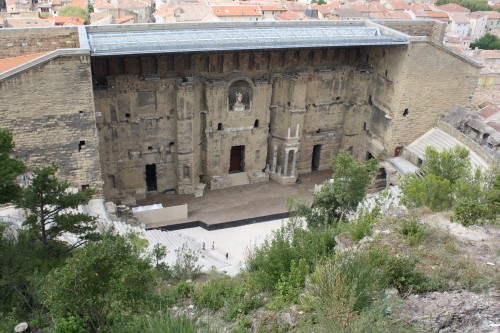
Stage Wall, Theatre of Orange
The exterior face of the stage wall is well-preserved and has 17 arched doorways separated by engaged columns. The central doors lead to the stage, the outer doors lead to staircases to access the cavea, and the rest are entrances to independent rooms not connected to the stage on the other side. Above the doorways are more pilasters (22 in total) and two rows of waterspouts. Each side of the wall ends in a series of monumental arched entrances built on two levels. At the side now used as a ticket office, there are the remains of the important sanctuary and temple, dedicated to an unidentified emperor.
The theatre was in use for several centuries and modified over time, but there are unfortunately no records of exactly which plays were performed in the theatre during antiquity. However, the most popular productions would have been pantomimes and mime shows, probably put on in festivals celebrating the imperial cult.
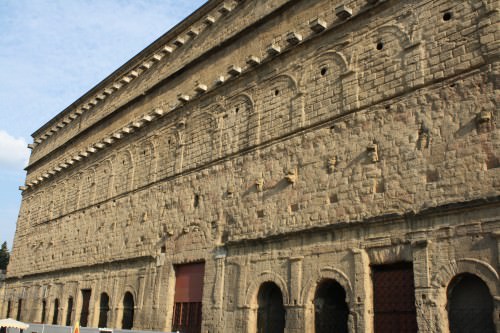
Exterior Stage Wall, Theatre of Orange
LATER HISTORY
Like most ancient monuments, the theatre has suffered a chequered history with its abandonment in antiquity followed by the indiscriminate reuse of its masonry, conversion into a fortress, and then incarnation as a residential block with, at one time, its own street running through it. Nevertheless, enough survived for Louis XIV to describe the massive and still-standing stage wall as 'The finest wall in my kingdom.' In the 19th century CE the theatre was restored by the architect Auguste Caristie, and from 1869 CE a series of artistic festivals known as the 'Roman Feasts' began. These events would later change their name to the 'Choregies,' and the tradition of classical concerts taking advantage of the theatre's excellent acoustics continues in the present day with an important summer festival of opera, theatre, and music presentations.
LICENSE
Article based on information obtained from these sources:with permission from the Website Ancient History Encyclopedia
Content is available under License Creative Commons: Attribution-NonCommercial-ShareAlike 3.0 Unported. CC-BY-NC-SA License